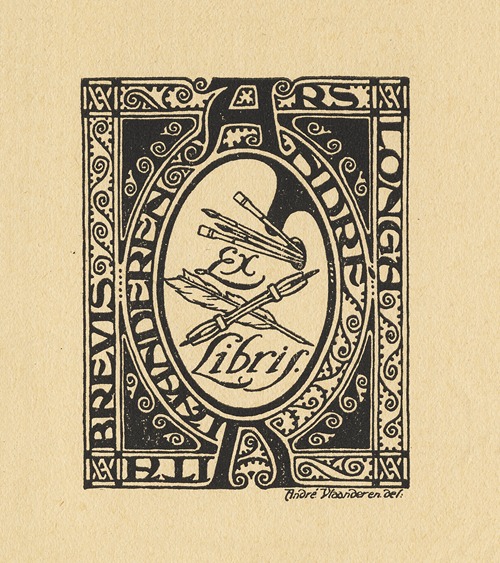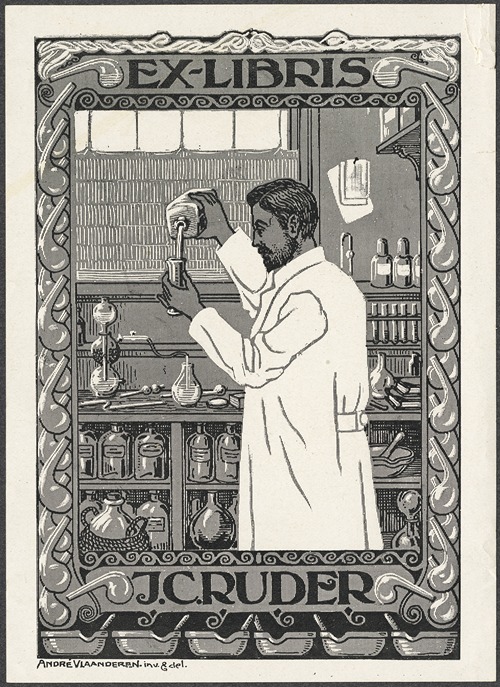

Cornelis André Vlaanderen was a Dutch graphic artist.
He was born to an unknown father. Because his mother, Anna Louisa Laura Agneta Vlaanderen, died on July 10, 1883, in Nieuwer Amstel, André Vlaanderen spent virtually his entire childhood as a pupil at the Hospice Wallon in Amsterdam. He left this orphanage in 1899.
After elementary school, he took classes at the Teekenschool voor Kunstambachten (School of Applied Arts) from 1895 to 1898. Vlaanderen enrolled there for a course in lithography. After successfully completing this course, he enrolled at the Rijksacademie voor Beeldende Kunsten (National Academy of Fine Arts) in Amsterdam in 1897. Between 1904 and 1910, he taught evening classes at the Kunstnijverheidsschool Quellinus Amsterdam (Quellinus School of Applied Arts).
From 1899 to 1905, Vlaanderen worked at the architectural firm of Eduard Cuypers, which was known as a training studio. Here he worked on the firm's publication Het Huis (The House), later Het Huis Oud en Nieuw (The House Old and New). He was responsible for the advertising section.
In 1905, Vlaanderen left Cuypers to start his own business. From then on, he designed many advertising commissions for various companies, including a lot of work for the Gazelle bicycle factory in Dieren. After Piet Pelle created the Gazelle logo, Vlaanderen designed a more serious advertising campaign. He started working for Gazelle in 1914 and continued to do so irregularly until 1953. During those 40 years, he was the designer of the company's advertising, ranging from price lists, advertisements in the trade press, and posters to the company's trademark and the headstock plate, which was designed in an art deco style. Every year, he managed to create a unique cover for the price lists. The advertisements, specially designed for the ANWB magazine Kampioen, were usually in the form of comic strips. In the 1910s and 1920s, he produced more than 500 advertisements for this magazine. Between 1920 and 1930, he also produced around 20 free promotional booklets for Gazelle.
Vlaanderen designed the well-known emblem for the AVRO and did a lot of drawing work for the Avrobode. He was also one of the contributors to the magazine De Bedrijfsreclame, which was first published in 1916. One company that distinguished itself by producing commemorative damask was the Koninklijke Weverij Van Dijk (Kodijko) in Eindhoven. From 1913 onwards, they wove designs by André Vlaanderen for occasions such as the centenary of Dutch independence (1813-1913), België Resurgat 1918-1919, League of Nations – World Peace 1919-1920, Wilhelmina 1898-1923, European World Peace (1919), the first flight from Amsterdam to Batavia by Van der Hoop with the Fokker F.VII H-NACC (1924) and the London-Melbourne race of the KLM DC-2 ‘Uiver’ PH-AJU (1934). In 1914, he was mobilized at Fort Velsen, where he converted the mountain shed into a theater with decorative panels.
He created countless book covers, jackets, and illustrations for around fifty publishers. Of these, 205 commissions have been found. He also designed posters; to date, 27 of these are known. An example of his art is the cover of Antiek toerisme. Roman uit Oud-Egypte (Antique Tourism: Novel from Ancient Egypt).
In August 1929, Vlaanderen settled in Belgium, first in Ghent and then, from August 1930, in Bruges. He initially lived in the suburbs of Sint-Andries and Assebroek, before moving to the historic city in 1939, where he lived at Spiegelrei 24 until his death.
He quickly integrated into the Bruges artistic world and became a member of the informal artists' association De Maffia.
Between 1940 and 1945, he created 160 bookplates, which are reproduced in the well-known book by A.G. Stainforth, CLX ex-librissen van André Vlaanderen, published in 1946; a sequel was published in 1992 with his remaining 69 bookplates.
He also made drawings and watercolors of Bruges cityscapes, which earned him a place in the so-called Bruges School.
In 1954, he held a rare retrospective exhibition in Bruges, featuring 71 paintings, chalk drawings, watercolors, and lithographs.
His ties with Amsterdam remained strong.

